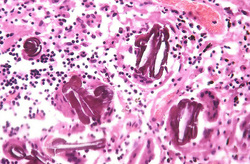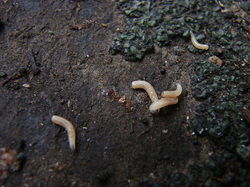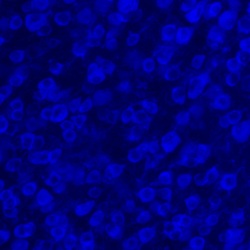 From Examiner.com A scathing new report on Celestial Seasonings teas and parent company Hain Celestial, shows 91% of the samples of Celestial Seasonings teas tested contained pesticides in levels that exceed U.S Federal limits.
High pesticides in 91% of samples
10 out of 11 varieties of Celestial Seasonings teas, one of the largest specialty tea manufacturers in North America, were found to contain excess pesticides in Antioxidant Max Blood Orange and Sleepytime Kids Goodnight Grape among other varieties.
From great beginnings...
Started in 1969, Celestial Seasonings was "founded on the belief that all-natural herbal teas could help people live healthier lives."
However, the tests conducted by EuroFins, an independent analytic testing company, determined that many varieties of Celestial Seasonings teas contained potentially dangerous levels of multiple pesticides.
The tests were part of a larger report by investment company Glaucus Research, which is highly critical of Celestial Seasonings parent company Hain Celestial.
READ THE FULL PESTICIDE REPORT
Read the full Glaucus report on Hain Celestial here. (Copies of the Eurofins pesticide test results begin on page 29, Appendix 1).
Hain Celestial responds, sort of
Celestial Seasonings through a spokesperson responded with a mostly cut and paste from the "values" page of their website about how they employ a "rigorous testing protocol" and that they are "confident that all Celestial Seasonings Teas deliver on...high quality, safety and taste..."
UPDATE: Celestial Seasonings has responded to customer inquiries based on this article on their Facebook page by saying the story "is based on a report issued by a “short seller,” an investment firm which stands to gain financially if our parent company’s stock declines."
This is true, but it distorts the fact that the report was actually created by an international independent testing lab, Eurofins, and that the short seller says they never touched the samples at any time.
CS added; "we strongly disagree with the misleading information contained within the report...We sent the same teas mentioned in the report for testing to the National Food Lab (NFL), an industry-leading third-party lab...NFL’s independent testing reaffirmed that Celestial Seasonings teas are safe and follow the strict guidelines established by the Food and Drug Administration (FDA) and Environmental Protection Agency (EPA).
We continue to reassure you now that Celestial Seasonings teas are still...safe...quality products."
Celestial Seasonings has samples tested by its own consultants
National Food Lab (NFL) however, proudly lists Celestial Seasonings as one of its clients on its website. Saying of its clients, "Somewhere along the line, we have had a hand in their success." NFL declined to comment on its report, citing "confidentiality."
A spokesperson at the Eurofins lab where the original testing took place says, "we stand behind the results we report to our tea clients."
Celestial Seasonings has not sent me their own report.
END UPDATE
How can Celestial Seasonings be so confident?
I wanted to believe Celestial Seasonings teas and Hain Celestial, I really did. So I asked them again if they had read the Glaucus report. Indeed they had they said.
So I asked, if you employ a "rigorous testing protocol" and are "confident" in the safety of your products, 'what went wrong? And are you planning to make changes and improvements to your process?'
The company had no further comment.
A poor track record for Celestial Seasonings teas
In 2009 Kay Wright, a botanicals purchaser for the company for over 30 years, was interviewed by TLC Cooking and claimed, "we do pride ourselves all the time on being very natural. It's company standards—not industry standards. We test absolutely everything, and not very many companies do that extensive testing."
Can short sellers be trusted?
Glaucus Research is an investment firm that specializes in short selling. Short selling is betting money that a stock price will go down.
Glaucus is "short" Hain Celestial and would benefit from bad news about the company, but their report is extremely well researched. And Glaucus runs the risk of being sued for fraud if it knowingly put out a false report.
In the report, released February 21, 2013, Glaucus says, "it is important to note that at no time did we take custody of, touch or handle any of the tea samples. Rather, we had the products shipped directly to Eurofins from the Company’s website and other online retailers."
Glaucus said it encourages others to repeat their tests. Glaucus further said, "the only way for consumers to make good food choices is if food producers are held accountable for the marketing and labeling of their products."
So, who can you trust for actually good sustainable tea? Twinings.
A report by rankabrand.org gives an A to Twinings teas, their highest rating for sustainability.
Incidentally, Celestial Seasonings got an 'E,' the lowest sustainability ranking.
The list of the Celestial Seasonings teas tested
The following were the teas that were tested by Eurofins. Only the Rooibos Safari Spice turned up zero pesticides, the rest exceeded Federal safety and/or California safety limits:
-Green Tea Peach Blossom
-Green Tea Raspberry Gardens
-Authentic Green Tea
-Antioxidant Max Dragon Fruit
-Green Tea Honey Lemon Ginger
-Antioxidant Max Blackberry Pomegranate
-Antioxidant Max Blood Orange
-Sleepytime Kids Goodnight Grape
-Sleepytime Herb Teas
-English Breakfast Black K-Cup
-Rooibos Safari Spice
A better way to solve this?
Perhaps the best way to settle this, is to have a Consumer Reports or Environmental Working Group type of organization buy samples off the shelves and send them to a lab.
DISCLOSURE: I have no investment position in HAIN.
 From Greenmed.infoNewly published research reveals that more frequent statin drug use is associated with accelerated coronary artery and aortic artery calcification, both of which greatly contribute to cardiovascular and all-cause mortality. Published Aug. 8th, 2012 in the journal Diabetes Care, researchers studied patients with type 2 diabetes and advanced atherosclerosis and found that coronary artery calcification "was significantly higher in more frequent statin users than in less frequent users." [i] Furthermore, in a subgroup of participants initially not receiving statins, "progression of both CAC [coronary artery calcification] and AAC [aortic artery calcification] was significantly increased in frequent statin users." What is perhaps most alarming about this new finding is that statin drugs have already been shown to significantly increase the risk of developing type 2 diabetes, prompting the FDA on Feb. 27th, 2011, to add "diabetes risk" to the warning label of all statin drugs marketed in this country. Now, with this latest discovery, it is safe to say, not only do statins likely induce type 2 diabetes in susceptible populations, but they also accelerate the cardiovascular complications associated with the disease -- a painfully ironic and highly concerning fact, considering that statins are supposed to reduce cardiovascular morbidity and mortality, not accelerate it. As we have explored in previous articles, this is probably only the tip of a massive iceberg of statin-associated adverse effects. Our ongoing database project has linked statin drugs to over 300 documented adverse health effects, not the least of which is the ability to weaken the heart muscle, or to increase the risk of type 2 diabetes by 48% in postmenopausal women. If you know someone on a statin drug, especially someone who also has diabetes or is at risk of developing it, please distribute this information to them, and expose them to the peer-reviewed and published research that already exists on potential naturals alternatives: Health Guide: Statin Drugs. [i] Aramesh Saremi, Gideon Bahn, Peter D Reaven, Progression of Vascular Calcification Is Increased With Statin Use in the Veterans Affairs Diabetes Trial (VADT). Diabetes Care. 2012 Aug 8. Epub 2012 Aug 8. PMID: 22875226
 (NaturalNews) If you post articles to your Facebook wall that warn others about the dangers of vaccines, or Tweet links to the latest studies tying vaccines to autism through Twitter, the vaccine pushers of the world could soon know about it in real time. According to new reports, Bill & Melinda Gates Foundation-backed scientists in both the United States and Great Britain have jointly developed a computerized global monitoring system capable of tracking all social media activity around the world that defies mainstream vaccine dogma, and reporting it directly to authorities. This brave new exercise in multinational, Big Brother spying is being hailed as a solution to the rapid spread of so-called "rumors" and "lies" about vaccines via the internet, which basically constitute any online free speech that questions the safety or effectiveness of vaccines. According to mainstream authorities, vaccines are completely safe and effective in every way, and anything that defies this unsubstantiated proclamation is now officially considered to be misinformation by the global police state. According to Heidi Larson from the London School of Hygiene & Tropical Medicine in the U.K., and author of the new tracking system, free speech on the internet has "speeded up the global spread" of what she and others consider to be "unchecked rumors and misinformation about vaccines." People thinking for themselves, in other words, and discussing legitimate vaccine safety concerns with others online is a threat to the establishment, thus the need for a virtual all-seeing eye, of sorts, to monitor all this chatter and report it directly to health officials. Bill Gates, vaccine industry desperately trying to maintain vaccine myth through intimidationThe real motivation behind the development of this new tracking tool, of course, is to increase vaccine compliance by intimidating people into silence. Since the Gates Foundation-backed vaccine pushers do not have the capacity to completely prohibit online free speech as it pertains to vaccines (at least not yet), they are instead resorting to underhanded intimidation and manipulation tactics that they hope will give them a new platform to spread their propaganda more quickly and thwart efforts that defy the vaccine status quo. This is all openly admitted by those who developed the new tracking platform using Gates Foundation funds, and it speaks for itself as to the true intentions of this sadistic cohort. An increasing number of people, for good reason, are avoiding vaccines, as study after study shows them to be toxic and largely ineffective. In fact, vaccines have been shown to be the cause of disease outbreaks, not the solution to them as claimed by Larson and others. So to stem this massive departure, the vaccine industry is seeking new ways to embed itself in the global discussion on vaccines in order to convince more people to get them. Just in case you were wondering, virtually all of the disease outbreaks in recent years that authorities claim were caused by unvaccinated individuals were actually most prominent among the vaccinated. In other words, the data shows that vaccinated individuals are actually more likely to contract diseases like mumps, measles, and polio than are children who have not been vaccinated, which completely debunks the myths that vaccines "save lives," and that not getting vaccinated puts one's health at serious risk. You can read more about how vaccines do not prevent disease outbreaks by visiting: http://vactruth.com/2013/02/23/17-examples-of-vaccine-failure/Sources for this article include:http://www.dailytelegraph.com.auhttp://www.medpagetoday.com/InfectiousDisease/Vaccines/39060http://vactruth.com/Learn more: http://www.naturalnews.com/040571_Gates_Foundation_vaccine_monitoring_dangers.html#ixzz2V1OT1oc8
 From Fox NewsDrinking just one can of sugar-laced soda drink a day increases the risk of developing diabetes by more than a fifth, according to a large European study published. Using data from 350,000 people in eight European countries, researchers found that every extra 12 fluid ounce (340 ml) serving of sugar-sweetened drink raises the risk of diabetes by 22 percent compared with drinking just one can a month or less. "Given the increase in sweet beverage consumption in Europe, clear messages on the unhealthy effect of these drinks should be given to the population," said Dora Romaguera, who led with study with a team at Imperial College London. A 12-fluid-ounce serving is about equivalent to a normal-sized can of Coca-Cola, Pepsi or other soft drink. The findings echo similar conclusions from research in the United States, where several studies have shown that intake of sugar-sweetened drinks is strongly linked with higher body weight and conditions like type 2 diabetes. Type 2 diabetes is a long-term condition characterized by insulin resistance that affects around 2.9 million people in Britain and, according to the World Health Organisation (WHO), more than 310 million people worldwide. Romaguera's team wanted to establish whether a link between sugary drinks and diabetes risk also existed in Europe. For their study, they used data from 350,000 people from Britain, Germany, Denmark, Italy, Spain, Sweden, France, Italy, Netherlands who were questioned about their diet, including how many sugary and artificially sweetened soft drinks and juices they drank each day. Writing in the journal Diabetologia, the researchers said their study "corroborates the association between increased incidence of Type-2 diabetes and high consumption of sugar-sweetened soft drinks in European adults". Fruit juice consumption was not linked to diabetes incidence. Patrick Wolfe, a statistics expert from University College London who was not involved in the research, said the message from its results was clear. "The bottom line is that sugary soft drinks are not good for you - they have no nutritional value and there is evidence that drinking them every day can increase your relative risk for type 2 diabetes," he said in an emailed comment. http://www.foxnews.com/health/2013/04/25/just-one-soda-increases-your-risk-diabetes-by-22-percent/#ixzz2RmexIQD7
 From Science Daily
There is a very good reason mothers often carry their crying babies, pacing the floor, to help them calm down. New research published in the Cell Press journal Current Biology on April 18 shows that infants experience an automatic calming reaction upon being carried, whether they are mouse or human babies.
The study is the first to show that the infant calming response to carrying is a coordinated set of central, motor, and cardiac regulations and an evolutionarily conserved component of mother-infant interactions, the researchers say. It might also explain a frustrating reality for new parents: that calm and relaxed very young children will so often start crying again just as soon as they are put back down.
"From humans to mice, mammalian infants become calm and relaxed when they are carried by their mother," says Kumi Kuroda of the RIKEN Brain Science Institute in Saitama, Japan. "This infant response reduces the maternal burden of carrying and is beneficial for both the mother and the infant."
In other words, a mother's arms really are the best place for a young baby to be in terms of his or her chances of survival. And mothers certainly appreciate a calm and relaxed baby. That babies naturally stop crying when they are carried is an evolutionary win-win.
The idea that this very familiar scenario also plays out in mice occurred to Kuroda while cleaning the cages of her lab's mouse colony. "When I picked the pups up at the back skin very softly and swiftly as mouse mothers did, they immediately stopped moving and became compact. They appeared relaxed, but not totally floppy, and kept the limbs flexed. This calming response in mice appeared similar to me to soothing by maternal carrying in human babies."
Kuroda and her colleagues found in careful tests that the heart rates of human babies slow immediately upon carrying. After they managed to find ECG monitor electrodes small enough to use on conscious mouse pups, the researchers found that the same goes for mice.
Both mouse and human babies also stop moving when they are carried. And when baby mice are carried, their ultrasonic cries stop, too.
The researchers traced that response in the mice to a sense known as proprioception, the way that information about body movements is perceived. They also found that particular parts of the brain and parasympathetic nervous system are key in mediating the coordinated response to carrying.
The findings have important implications for parenting and may even play a role in preventing child abuse, the researchers say, by helping grownups see things from an infant's point of view.
"A scientific understanding of this infant response will save parents from misreading the restart of crying as the intention of the infant to control the parents, as some parenting theories -- such as the 'cry it out' type of strategy -- suggest," Kuroda says. "Rather, this phenomenon should be interpreted as a natural consequence of the infant sensorimotor systems."
If parents understand that properly, perhaps they will be less frustrated by the crying, Kuroda says. And that puts those children at lower risk of abuse.
 Maggots Heal Wounds From Scientific American
New studies show how maggots clean wounds and help them heal By Carrie Arnold From ancient times until the advent of antibiotics, physicians used maggots to help clean injuries and prevent infection. Because the maggots feed solely on dead flesh, doctors did not have to worry about bugs feasting on healthy tissue. The arrival of antibiotics relegated medical maggots to an artifact of an earlier era. Widespread antibiotic resistance, however, rekindled interest in the use of medical maggots, and in 2004 the fda approved them as a valid “medical device.” Today maggot providers raise the larvae from sterilized fly eggs and place them in tea bag–like packages that physicians apply directly to wounds. (The packages prevent the maggots from crawling off and completing their maturation into adult flies.) As more physicians have turned to the insects to treat wounds, scientists have uncovered the two-pronged process by which maggots work their magic. One study published last year in the Archives of Dermatology showed that maggots placed on surgical incisions helped to clear more dead tissue from the sites than surgical debridement, the current standard of care in which doctors use a scalpel or scissors. “Maggot debridement takes out all the dead and infected tissue, which is necessary for the wound to close,” says lead author Anne Dompmartin-Blanchère, a dermatologist at the University Hospital Center of Caen in France. Surgical debridement is often lengthy and painful, something that maggot therapy eliminates, she adds. A separate study published late last year in Wound Regeneration and Repair by Gwendolyn Cazander of Leiden University Medical Center in the Netherlands and her colleagues found that secretions from the maggots modulate the complement response, a part of the immune system that reacts to invading pathogens and is crucial to clearing infections. Some complement activation is necessary, but too much complement leads to chronic inflammation, which can keep injuries open and vulnerable to infection. Maggot secretions turned down complement activity in blood samples from healthy adults by inhibiting the production of several important complement proteins, and, the researchers found, reducing this overactive immune response speeds up healing. “About 50 to 80 percent of the wounds we see can be healed with maggots,” Cazander concludes. Maggot therapy might sound medieval, but modern medicine seems to show that it works.
 Smoking and Cancer From cancerresearchuk.org Smoking and cancer: What's in a cigarette? A cigarette may look harmless enough - tobacco leaves covered in classic white paper. But when it burns, it releases a dangerous cocktail of about 4,000 chemicals including: - more than 70 cancer-causing chemicals
- hundreds of other poisons.
- nicotine, a highly addictive drug, and many additives designed to make cigarettes taste nicer and keep smokers hooked.
This page has more information on the various poisons in cigarette smoke. You can also read about where these come from and how concentrated they actually are. Cancer-causing chemicals in tobacco smoke Other poisons in cigarette smoke Tar Tar is a term that describes a collection of solid particles that smokers inhale when they light a cigarette. It is a mixture of lots of chemicals, many of which can cause cancer. When it settles, tar forms a sticky, brown residue that can stain smokers’ teeth, fingers and lungs. Because tar is listed on packs, it is easy to believe that it is the only harmful part of cigarettes. But some of the most dangerous chemicals in tobacco smoke are present as gases, and do not count as part of tar. This means that cigarettes with less tar still contain all the other toxic chemicals. Arsenic Arsenic is one of the most dangerous chemicals in cigarettes. It can cause cancer as well as damaging the heart and its blood vessels. Small amounts of arsenic can accumulate in smokers’ bodies and build up to higher concentrations over months and years. As well as any direct effects, it can worsen the effect of other chemicals by interfering with our ability to repair our DNA. Fish and seafood can be major sources of arsenic, but in a form that is less toxic and more readily removed from the body. In contrast, tobacco smoke contains arsenic in a more dangerous form. Benzene Benzene is a solvent used to manufacture other chemicals, including petrol. It is well-established that benzene can cause cancer, particularly leukaemia. It could account for between a tenth and a half of the deaths from leukaemia caused by smoking. Tobacco smoke contains large amounts of benzene and accounts for a big proportion of our exposure to this poison. The average smoker inhales about ten times more benzene than the average non-smoker. And some studies have estimated that the amount of benzene that a person inhales through second-hand smoke over their lifetime could increase their risk of cancer. Cadmium Cadmium is a metal used mostly to make batteries. The majority of cadmium in our bodies comes from exposure to tobacco smoke. Smokers can have twice as much cadmium in their blood as non-smokers. Studies have found that the amounts of cadmium present in tobacco smoke are capable of affecting our health. It is a known cause of cancer, and can also damage the kidneys and the linings of the arteries. Our bodies have proteins that mop up harmful chemicals like cadmium, but the amounts in smoke can overload these proteins. Cadmium can also prevent our cells from repairing damaged DNA. Because of this, it can make the effects of other chemicals even worse. Formaldehyde Formaldehyde is a smelly chemical used to kill bacteria, preserve dead bodies and manufacture other chemicals. It is one of the substances in tobacco smoke most likely to cause diseases in our lungs and airways. Formaldehyde is also a known cause of cancer. It is believed that even the small amounts in second-hand smoke could increase our lifetime risk of cancer. Tobacco smoke is one of our major sources of formaldehyde exposure. Places where people smoke can have three times the normal levels of this poison. Polonium-210 Polonium is a rare, radioactive element and polonium-210 is its most common form. Polonium strongly emits a very damaging type of radiation called alpha-radiation that can usually be blocked by thin layers of skin. But tobacco smoke contains traces of polonium, which become deposited inside their airways and deliver radiation directly to surrounding cells. The lungs of smokers can be exposed to four times more polonium than those of non-smokers and specific parts may get a hundred times more radiation. One study estimated that someone smoking one and half packs a day receives the equivalent amount of radiation as someone having 300 chest X-rays a year. Chromium Chromium is a metal used to make metallic alloys, dyes and paints and comes in different types. Chromium III or ‘trivalent chromium’ is most commonly used. It is available as dietary supplements and is harmless. On the other hand, chromium VI or ‘hexavalent chromium’ is very toxic, is found in tobacco smoke, and is known to cause lung cancer. It allows other cancer-causing chemicals (such as polycyclic aromatic hydrocarbons) to stick more strongly to DNA and damage it. 1,3-Butadiene 1,3-butadiene or BDE is an industrial chemical used in rubber manufacture. Some scientists believe that of all the chemicals in tobacco smoke, BDE may present the greatest overall cancer risk. It may not be as good at causing cancer as some of the other chemicals listed here, but it is found in large amounts in tobacco smoke. Polycyclic aromatic hydrocarbons
Polycyclic aromatic hydrocarbons or PAHs are a group of powerful cancer-causing chemicals that can damage DNA and set cells down the road to becoming tumours. One of these chemicals - benzo(a)pyrene or BAP - is one of the most widely studied of all tobacco poisons. BAP directly damages p53, a gene that normally protects our bodies against cancer. Nitrosamines Nitrosamines are a group of chemicals that can directly damage DNA, like polycyclic aromatic hydrocarbons (PAHs). They are found in small amounts in food. But tobacco products, including those that are chewed rather than smoked, are by far our largest source of exposure to these chemicals. Even though they are found in relatively small amounts in cigarettes, they are very strong cancer-causing chemicals. Acrolein
Acrolein is a gas with an intensely irritating smell and is one of the most abundant chemicals in cigarette smoke. It belongs to the same group of chemicals as formaldehyde and acetaldehyde, both of which can cause cancer. Until now, it wasn’t clear if acrolein causes cancer as well, but recent experiments suggest that it can. We now know that acrolein can cause DNA damage that is similar to the damage seen in lung cancer patients. Since smoke contains up to 1,000 times more acrolein than other DNA-damaging chemicals, it could be a major cause of lung cancer. Acrolein also stops our cells from repairing DNA damage, like arsenic and cadmium. And like hydrogen cyanide, it kills the hairs that normally clean our lungs of other toxins. Other chemicals Some of the other cancer-causing ingredients of tobacco smoke include: - metals, such as nickel, lead, cobalt and beryllium. While you may be exposed to some of these metals through domestic items or food, inhaling them in tobacco smoke is worse, because they are easily absorbed by the lungs.
- acetaldehyde, which is also formed in your tissues when you drink alcohol - it is responsible for many nasty hangover symptoms
- hydrazine, a very toxic chemical used mainly in rocket fuel
Hydrogen cyanide Hydrogen cyanide is a poisonous gas. Of all the chemicals in tobacco smoke, it does the most damage to the heart and blood vessels. Hydrogen cyanide does not cause cancer, but it increases the risk of other chemicals causing cancer by damaging cilia. These are tiny hairs lining the airways that help to clear toxins away. By killing cilia, hydrogen cyanide causes other dangerous chemicals to be stuck in the lungs and airways. Carbon monoxide
Carbon monoxide is a colourless gas with no smell. It is formed when we burn carbon-based fuels, such as gas in cookers or petrol in car engines. It can make up as much as 3-5% of tobacco smoke. Carbon monoxide sticks to our red blood cells in place of oxygen. This lowers our blood’s ability to transport oxygen and deprives our tissues and organs of this vital gas. Like hydrogen cyanide, it kills cilia and reduces our lungs’ ability to clear away toxins. This means that while carbon monoxide does not cause cancer directly, it makes it easier for other chemicals to do so. Nitrogen oxide
Nitrogen oxide is a gas found in car exhaust and tobacco smoke. Our bodies use it in very small amounts to carry signals between cells. But in large amounts, it is a major air pollutant. It directly damages lung tissue and causes inflammation in the lungs. Normally, our bodies produce small amounts of nitrogen oxide, which causes our airways to expand. The large amount of nitrogen oxide in tobacco smoke changes things in two ways: - When smokers are smoking, it expands their airways even further, making it easier for their lungs to absorb nicotine and other chemicals.
- When they are not smoking, it shuts off their internal nitrogen oxide production line, causing their airways to constrict. This is one reason why regular smokers often have difficulty breathing.
Ammonia Ammonia is a gas with a strong, irritating smell, and is used in some toilet cleaners. Some studies have found that ammonia enhances the addictive power of nicotine. It changes nicotine into a gas that is more readily absorbed into the lungs, airways and bloodstream. Like carbon monoxide and hydrogen cyanide, ammonia also kills cilia. More poisons Tobacco smoke also contains many other poisons that produce harmful effects. These can be carried throughout the body via our blood vessels. As well as hydrogen cyanide and ammonia, gases like sulphur dioxide also kill cilia (protective hairs) in our lungs. This stops them from being able to clear away other harmful chemicals. Chemicals like hydrogen sulphide and pyridine irritate our airways. Toluene can damage brain cells and interfere with their development.
 From Science Daily Apr. 5, 2013 — Researchers at the University of East Anglia (UEA) have made a discovery in neuroscience that could offer a long-lasting solution to eating disorders such as obesity. It was previously thought that the nerve cells in the brain associated with appetite regulation were generated entirely during an embryo's development in the womb and therefore their numbers were fixed for life. But research published today in the Journal of Neuroscience has identified a population of stem cells capable of generating new appetite-regulating neurons in the brains of young and adult rodents. Obesity has reached epidemic proportions globally. More than 1.4 billion adults worldwide are overweight and more than half a billion are obese. Associated health problems include type 2 diabetes, heart disease, arthritis and cancer. And at least 2.8 million people die each year as a result of being overweight or obese. The economic burden on the NHS in the UK is estimated to be more than £5 billion annually. In the US, the healthcare cost tops $60 billion. Scientists at UEA investigated the hypothalamus section of the brain -- which regulates sleep and wake cycles, energy expenditure, appetite, thirst, hormone release and many other critical biological functions. The study looked specifically at the nerve cells that regulate appetite. The researchers used 'genetic fate mapping' techniques to make their discovery -- a method that tracks the development of stem cells and cells derived from them, at desired time points during the life of an animal. They established that a population of brain cells called 'tanycytes' behave like stem cells and add new neurons to the appetite-regulating circuitry of the mouse brain after birth and into adulthood. Lead researcher Dr Mohammad K. Hajihosseini, from UEA's school of Biological Sciences, said: "Unlike dieting, translation of this discovery could eventually offer a permanent solution for tackling obesity. "Loss or malfunctioning of neurons in the hypothalamus is the prime cause of eating disorders such as obesity. "Until recently we thought that all of these nerve cells were generated during the embryonic period and so the circuitry that controls appetite was fixed. "But this study has shown that the neural circuitry that controls appetite is not fixed in number and could possibly be manipulated numerically to tackle eating disorders. "The next step is to define the group of genes and cellular processes that regulate the behaviour and activity of tanycytes. This information will further our understanding of brain stem cells and could be exploited to develop drugs that can modulate the number or functioning of appetite-regulating neurons. "Our long-term goal of course is to translate this work to humans, which could take up to five or 10 years. It could lead to a permanent intervention in infancy for those predisposed to obesity, or later in life as the disease becomes apparent." The research was funded by the Wellcome Trust.
 By Leslie Wade, CNN(CNN) -- Sugar-sweetened beverages are linked to more than 180,000 obesity-related deaths worldwide each year, according to new research presented this week at an American Heart Association conference. "This means about one in every 100 deaths from obesity-related diseases is caused by drinking sugary beverages," says study author Gitanjali Singh, a postdoctoral research fellow at the Harvard School of Public Health. Among the world's 35 largest countries, Mexico had the highest death rates from sugary drinks, and Bangladesh had the lowest, according to the study. The United States ranked third. However, the American Beverage Association dismissed the research as "more about sensationalism than science."
 From Science NewsA component of bee venom packaged in super-tiny blobs can knock out HIV, a new study finds. Researchers testing the delivery system in lab dishes report that these nanoparticles attach to and destroy the virus without damaging cells, offering an early glimpse of a technology that might — with a lot more testing — prevent HIV infection in some people. “This is definitely a novel approach,” says Antony Gomes, a physiologist at the University of Calcutta in India, who studies the medical use of venoms. “There are very few reports available on venom-based treatment against viruses. This type of research has the potential to proceed further for product development.”
|










